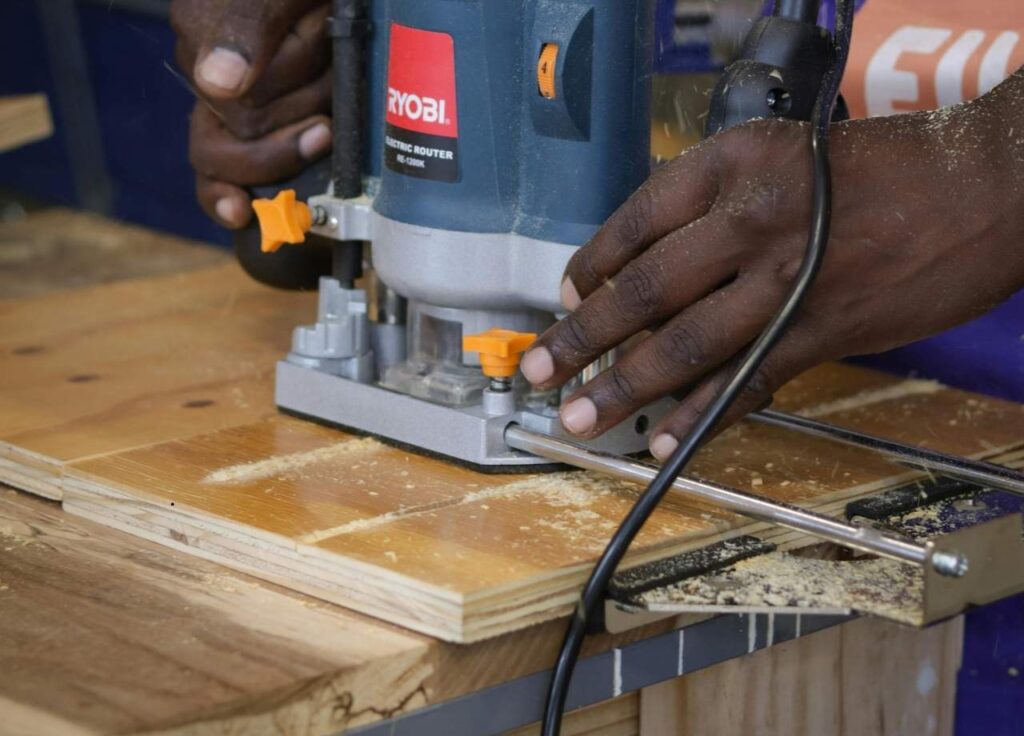Router tables are a staple in many professional workshops, offering unmatched precision and versatility in woodworking and finish carpentry. For contractors looking to streamline production, increase accuracy, and improve safety, a router table is one piece of equipment that can make a measurable impact on the jobsite or in the shop. Whether you specialize in cabinetry, trim work, or custom millwork, understanding how router tables function and what features to look for can significantly improve your workflow.
BC Industrial Supply offers a wide selection of router tables and accessories for contractors who demand reliability and performance, along with expert support to help you find the right setup for your needs.
Table of Contents
What Is a Router Table?
At its core, a router table is a stationary woodworking machine that holds a handheld router upside down, allowing the bit to protrude through a hole in the table surface. This setup turns a portable tool into a precision station, making it easier to work with smaller or more detailed pieces and freeing up both hands for better control.
Unlike using a handheld router where the operator guides the tool over the material, the router table allows you to guide the material over the spinning bit. This is especially beneficial for repetitive tasks, intricate joinery, or routing smaller parts that would be difficult to control with a handheld unit.
Advantages of Using a Router Table
Router tables give contractors greater precision in shaping edges, cutting grooves, rabbets, dados, and joinery. The added support of the table surface and fence system ensures smoother, straighter cuts and reduces operator fatigue.
One of the key advantages is repeatability. Once the fence and bit height are dialed in, contractors can run multiple identical parts without resetting. This saves time and helps maintain consistency across projects, especially in cabinetry or architectural millwork where uniformity matters.
A router table also enhances safety. With the router mounted upside down and secured, there’s less chance of the tool kicking back or slipping during a cut. Safety accessories like featherboards, push blocks, and guards can be added to further reduce risk.
Types of Router Tables
Router tables come in a variety of configurations to suit different jobsite or shop environments. The most common types include benchtop router tables, standalone floor models, and router table extensions that attach to a table saw.
Benchtop router tables are compact and portable, ideal for smaller shops or contractors who need mobility. These units are lightweight and can be stored easily when not in use, but they may lack the stability or work surface area of larger models.
Standalone or cabinet-style router tables provide a larger work surface and greater stability. Many include storage for bits and accessories and often feature integrated dust collection ports. These are a better option for contractors who perform frequent or large-scale routing operations.
Table saw router extensions combine a router table with an existing table saw, saving space and allowing for longer stock support. This setup can be very efficient but typically requires more permanent installation.
Key Components and Features to Consider
Several components determine the effectiveness and ease of use of a router table. The top surface should be flat and rigid, made of high-pressure laminate, phenolic, or cast iron to resist warping and vibration. A high-quality fence is crucial for accurate routing; look for one that is adjustable, locks securely, and includes dust collection.
The router lift mechanism is another critical component. A good lift allows for precise bit height adjustments from above the table without removing the router. This saves time and ensures more accurate setups. Some tables come with built-in lifts, while others allow for aftermarket lifts to be installed.
Insert plates are used to mount the router to the table. They should be flat, strong, and compatible with your router model. Look for leveling screws and secure locking systems to keep the plate flush with the table surface.
Dust collection ports are essential, especially in enclosed workshops. Routing creates fine dust that can quickly become a safety hazard. Most quality router tables have built-in dust ports, typically located in the fence or below the table, allowing you to connect to a shop vac or dust extractor.
Choosing the Right Router and Router Table Combo
Not all routers fit all tables. Before committing to a setup, verify compatibility. Some tables are designed for specific brands or sizes of routers, while others are more universal. Routers with variable speed control are preferable because different bits perform best at different speeds.

Power is another consideration. A 2-1/4 to 3-1/4 HP router is usually sufficient for most contractor applications. Larger bits and hardwoods require more power to maintain clean, consistent cuts. If your routing tasks involve heavy-duty milling or frequent use, invest in a high-torque model.
Contractors should also evaluate how easy it is to change bits and make adjustments. Models with above-the-table access to the collet and height controls simplify the process, reducing downtime and frustration.
Router Table Safety Best Practices
Even with the added safety of a stationary setup, proper practices are essential. Always use push blocks and featherboards to keep your hands away from the bit. Make sure the bit is properly secured in the collet, and never force the material through the cut.
Check the direction of feed relative to the rotation of the bit. Feeding the stock in the wrong direction can cause kickback. The correct direction is typically from right to left across the front of the table.
Before each cut, double-check that all components are secure: the bit, the fence, and the insert plate. Also confirm that dust collection is connected and functioning. Wearing hearing and eye protection is a must.
Common Router Table Applications in Contracting
Contractors use router tables for a range of tasks that require detail and consistency. Edge profiling with round-over, ogee, or chamfer bits is one of the most common uses, giving trim and cabinetry a clean, professional finish.
Joinery is another major application. Router tables are ideal for cutting dados, rabbets, box joints, and tongue-and-groove profiles. These joints are essential in cabinetry, casework, and furniture building.
Flush trimming with a bearing-guided bit can be done more easily and accurately on a router table, especially when working with laminate or veneer. Templates and jigs further expand the router table’s capability for complex or repetitive shapes.
Maintaining Your Router Table
To keep your router table performing at its best, routine maintenance is essential. Keep the surface clean and waxed to reduce friction and prevent corrosion. Periodically check that all screws and bolts are tight, and inspect the router lift and insert plate for wear.
Bit maintenance is just as important. Dull or gummed-up bits can cause burning and tear-out. Clean bits regularly and sharpen or replace them as needed.
Dust collection systems should also be maintained. Clogged hoses or filters reduce suction and allow harmful dust to accumulate.
Final Thoughts
A well-chosen router table can transform the efficiency and quality of a contractor’s work. Whether you’re fine-tuning edge details or building custom joinery, the stability, safety, and control of a router table can pay dividends over time. Understanding the options and features helps you make an informed investment that supports your craft and your business.

